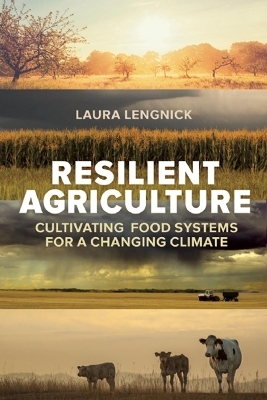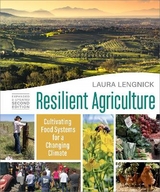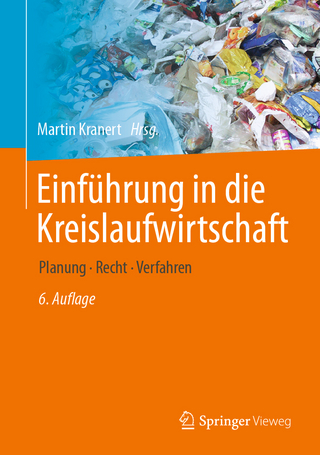
Resilient Agriculture
New Society Publishers (Verlag)
978-0-86571-774-9 (ISBN)
- Titel erscheint in neuer Auflage
- Artikel merken
Climate change presents an unprecedented challenge to the productivity and profitability of agriculture in North America. More variable weather, drought, and flooding create the most obvious damage, but hot summer nights, warmer winters, longer growing seasons, and other environmental changes have more subtle but far-reaching effects on plant and livestock growth and development. Resilient Agriculture recognizes the critical role that sustainable agriculture will play in the coming decades and beyond. The latest science on climate risk, resilience, and climate change adaptation is blended with the personal experience of farmers and ranchers to explore: * The "strange changes" in weather recorded over the last decade * The associated shifts in crop and livestock behavior * The actions producers have taken to maintain productivity in a changing climate The climate change challenge is real and it is here now. To enjoy the sustained production of food, fiber, and fuel well into the twenty-first century, we must begin now to make changes that will enhance the adaptive capacity and resilience of North American agriculture.
The rich knowledge base presented in Resilient Agriculture is poised to serve as the cornerstone of an evolving, climate-ready food system. Laura Lengnick is a researcher, policymaker, activist, educator, and farmer whose work explores the community-enhancing potential of agriculture and food systems. She directs the academic program in sustainable agriculture at Warren Wilson College and was a lead author of the report Climate Change and Agriculture in the United States: Effects and Adaptation.
Laura Lengnick has been actively exploring the community-enhancing potential of agriculture and food systems for more than 30 years. Through her work as a researcher, policymaker, activist, educator and farmer, she has gained the expertise necessary to better understand what it takes to move sustainability values into action at every level. Laura has been nationally recognized for her advocacy work with a USDA Secretary's Honor Award, and she contributed to the 3rd National Climate Assessment as a lead author of the report Climate Change and U.S. Agriculture: Effects and Adaptation. She directs the academic program in sustainable agriculture at Warren Wilson College in Asheville, NC, and spends much of her free time growing food using biointensive and permaculture methods.
Book Proposal: Annotated Chapters
Sustaining Agriculture in a Warming World: The Climate Change Challenge and the Promise of Sustainable Agriculture
Chapter 1: Sustaining Agriculture in a Warming World
Introduces concepts of global warming and climate change and presents current and projected climate changes in the U.S. by region as reported in the 3rd National Climate Assessment (scheduled for release in April 2014). Explains that climate scientists now see that early climate change effects can be detected starting in the early 1980’s and the pace and intensity of climate change has increased in the last decade. Presents an overview of American agriculture organized according to the USDA-ERS Farm Resource Regions – what is grown where, how much does each region contribute to our food supply to connect the specific climate effects to specific agricultural resource regions. Discusses why climate change presents an unprecedented challenge to agricultural sustainability in the context of 21st century resource scarcity and that sustainable agriculture is widely recommended as a path to reduce vulnerability to climate change. Introduces the rationale for the book: I interviewed nationally-recognized sustainable farmers who have been farming more than 30 years to ground the climate science with perspectives from those with real experience managing climate change effects. I wanted to learn more about their experience of climate change: What kinds of effects were they experiencing on their farms? How have they responded and have their adaptations been successful? Are they hopeful for the future – do they think that sustainable agriculture have the capacity to cope with climate change effects projected for this century?
Chapter 2: Agricultural Vulnerability to Climate Change: Exposure, Sensitivity and Adaptive Capacity
Introduces the concept of agricultural risk in farm management. and describes how climate risk has emerged as a novel production risk in the last decade. Presents recent research-based evidence to support a discussion of climate vulnerability. Climate vulnerability of a system (a farm or a community) is determined by three different components: exposure, sensitivity and adaptive capacity. Exposure describes the climate events likely to be experienced in a specific locale. For example, all locales will experience increased CO2 concentration, but only some locales will experience floods. Current and projected exposures relevant to agriculture and regional differences in key exposures will be presented in this section. Sensitivity describes the potential damage to the system of a climate event. Some kinds of production systems are very sensitive to specific types of climate events, others are not. For example, tree fruit production systems are robust to drought and flood because of plant architecture, but very sensitive to a freeze during bloom – the whole fruit crop can be destroyed in a matter of a few hours with a late spring freeze. Annual vegetable production is much less sensitive to variable spring temperatures because spring vegetable crops are robust to cold snaps and vegetables are planted in succession – so if an extreme event damages one planting, the next planting can replace it with little loss of production. But annual vegetables are very sensitive to drought and flood events. Key crop and livestock and farm resource sensitivities will be presented in this section. Adaptive capacity describes the ability of the system respond to a climate event, prevent or recover from the damage and remain productive. This recovery is supported by human response as well as ecosystem response. For example, healthy soils can absorb more water falling on the soil surface from an extreme rainfall event – this means less overland flow, less soil erosion and less water added to surface water flow which reduces potential flooding. Adaptive capacity will introduced in this chapter, but will be fully explored in Chapter 2.
Chapter 3. Adaptive Capacity and Resilience
Introduces resilience concepts, explains relationship to adaptive capacity and fully develops concepts of adaptive capacity and resilience in agricultural systems. Resilient systems have high adaptive capacity – both terms describe the ability of a system to absorb or adjust to disturbance in a way that maintains structure and function. For example, healthy soils contribute to farm system resilience by mediating variable precipitation as described in Chapter 1. The adaptive capacity of a system is determined by three different components: the operating context (social, ecological and economic), existing knowledge and options, and individual capability to act. The operating context describes the constraints on the system to respond to a disturbance – these may be ecological (poor soil health), social (no policy support to maintain/build soil health), or economic (market does not support soil health). Existing knowledge and options describes the state of understanding of resilience and what technological and other tools are available to enhance resilience of the system. For example, we know that soil health enhances resilience (knowledge), but we can’t yet recommend a range of specific practices to increase resilience under different local conditions (options). Individual capability describes the human resources needed for effective decision-making. For example, soil health enhances farm resilience, but a farmer must understand how to build soil health and have a desire to build soil health in order to take action.
Chapter 4 – Fruit Production
Key Exposures: Variable Temperatures, Warmer Winters
Key Sensitivity: Temperature Thresholds
Key Adaptive Responses: Managing Microclimates, Frost Protection, Low Chill Varieties
Potential Farmers: Ed and Wynette Sills, Pleasant Grove, California, Larry Thompson, Boring, Oregon, Jonathan Bishop, Guilford, Connecticut
Chapter 5 – Grain Production
Key Exposures: Variable Precipitation, increased CO2 and pest pressures
Key Sensitivity: Timing of planting/harvest, drought during grain fill, early maturity
Key Adaptive Responses: Variety selection, crop diversity, livestock integration
Potential Farmers: Dick & Sharon Thompson, Boone, Iowa, Bob Quinn, Big Sandy, Montana, Rich Bennett, Napoleon, Ohio, Carmen Fernholz, Madison, Minnesota
Chapter 6 – Meat and Dairy Production
Key Exposures: Heat waves, increased pest pressures
Key Sensitivity: Prolonged periods of intense heat and cold
Key Adaptive Responses: Variety selection, age and species diversity, pasture-based production
Potential Farmers: Greg & Lei Gunthorp, LaGrange, Indiana, Richard & Peggy Sechrist, Fredericksburg, Texas, Tom Trantham, Pelzer, South Carolina, Tom Larson, Saint Edward, Nebraska, Gordon & Marion Jones, Chichester, New Hampshire
Chapter 7 – Vegetable Production
Key Exposures: Variable Temperature and Precipitation, extreme weather events, pollinator disruption
Key Sensitivity: Pollination and fruit development, pest damage, product quality
Key Adaptive Responses: Variety selection, crop diversity, irrigation, physical protection
Confirmed Farmers: Elizabeth Henderson, Newark, New York and Mike Heath, Buhl, Idaho and Alex & Betsy Hitt, Graham, North Carolina have all agreed to be interviewed for this project.
Potential Farmers: I have not yet received a response to my request for an interview from the following farmers: Steve & Cheri Groff, Holtwood, Pennsylvania , Lon Inaba, Wapato, Washington, Richard DeWilde & Linda Halley, Viroqua, Wisconsin, and Larry Thompson, Boring, Oregon, and Dosi and Norma Alverez, La Union, New Mexico.
Chapter 8: New Times, New Tools
Introduces the new kinds of knowledge and tools needed to support the development of climate ready agriculture presented through the climate vulnerability framework. Exposure: What do farmers need from climate scientists to improve strategic planning, particularly long-term investments? Sensitivity: What kinds of information can agricultural scientists provide to help us understand the productivity impacts of specific sensitivities and interactions? Adaptive capacity: What government policy and programs are needed to improve operating context? What changes in ecosystem health and natural resource quality? What can research and technical advisors do to improve knowledge and tools? How do we create climate-ready managers capable
| Erscheint lt. Verlag | 2.6.2015 |
|---|---|
| Verlagsort | Gabriola Island |
| Sprache | englisch |
| Maße | 152 x 229 mm |
| Gewicht | 479 g |
| Themenwelt | Naturwissenschaften ► Biologie ► Ökologie / Naturschutz |
| Sozialwissenschaften ► Politik / Verwaltung ► Staat / Verwaltung | |
| Weitere Fachgebiete ► Land- / Forstwirtschaft / Fischerei | |
| ISBN-10 | 0-86571-774-5 / 0865717745 |
| ISBN-13 | 978-0-86571-774-9 / 9780865717749 |
| Zustand | Neuware |
| Informationen gemäß Produktsicherheitsverordnung (GPSR) | |
| Haben Sie eine Frage zum Produkt? |
aus dem Bereich



